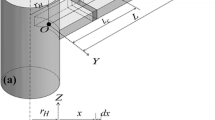Abstract
This paper presents a new boundary element application for free vibration analysis of 2D elastic structures. The dual reciprocity method is applied using four compact supported radial basis functions for approximating the domain inertia terms. The eigen-problem of displacement is then solved considering the traction contribution by means of static condensation. The formulation is also extended to consider additional internal nodes to improve accuracy. Three numerical problems are studied to demonstrate the validity and accuracy of the developed formulation. The results are compared to those obtained from analytical and other numerical solutions. A parametric study is set up to demonstrate the effect of the compact support radius on the final results and on the sparsity of system matrices.
Similar content being viewed by others
References
Brebbia CA, Telles JCF, Wrobel LC (1984) Boundary element techniques: theory and applications in engineering. Springer, Berlin
Dominguez J (1993) Boundary element in dynamics. Computational mechanics publications, Southampton; Elsevier Applied Science, London
Nerantzaki MS, Katsikadelis JT (1996) An analog equation solution to dynamic analysis of plates with variable thickness. Eng Anal Bound Elem 17:145–152
Nardini D, Brebbia CA (1982) A new approach to free vibration analysis using boundary elements. In: Proceedings of 4th international conference on boundary elements. Computational Mechanics Publications, Southampton; Springer, Berlin, pp 313–326
Partridge P W, Brebbia CA, Wrobel LC (1992) The dual reciprocity boundary element method. Computational Mechanics Publications, Southampton; Elsevier Applied Science, London
Agnantiaris JP, Polyzos D, Beskos DE (1996) Some studies on dual reciprocity BEM for elastodynamic analysis. Comput Mech 17:270–277
Rashed YF (2002) Transient dynamic boundary element analysis using Gaussian based mass matrix. Eng Anal Bound Elem 26:265–279
Telles JCF, Carrer JMA (1994) Static and transient dynamic non-linear stress analysis by the boundary element method with implicit techniques. Eng Anal Bound Elem 14:65–74
Venturini WS (2000) Dynamic non-linear stress analysis by the mass matrix BEM. Eng Anal Bound Elem 24:623–632
Niku SM, Adey RA (1996) Computational aspect of the dual reciprocity method for dynamics (technical note). Eng Anal Bound Elem 18:43–61
Nardini D, Brebbia CA (1983) A new approach to free vibration analysis using boundary elements. Appl Math Model 1:157–162
Brebbia CA, Nardini D (1983) Dynamic analysis in solid mechanics by an alternative boundary elements procedure. Int J Soil Dyn Earthq Eng 2:228–233
Bridges TR (1986) Eigenvalue calculation by the dual reciprocity boundary element method using augmented thin plate spline, Ph.D. thesis. Wessex Institute of Technology, University of Wales
Agnantiaris JP, Polyzos D, Beskos DE (1998) Three-dimensional structural vibrations analysis by the dual reciprocity BEM. Comput Mech 21:372–381
Wilson RB, Miller NM, Banerjee PK (1990) Free-vibration analysis of three-dimensional solids by BEM. Int J Numer Methods Eng 29:1737–1757
Mehraeen S, Noorzad A Application of radial basis functions on dual reciprocity BEM for dynamic analysis of pierced shear wall. Bound Elem XXIII:299–308
Agnantiaris JP, Polyzos D, Beskos DE (2001) Free vibration analysis of non-axisymmetric and axisymmetric structures by the dual reciprocity BEM. Eng Anal Bound Elem 25:713–723
Golberg MA, Chen CS (1994) The theory of radial basis functions applied to the BEM for inhomogeneous partial differential equations. Bound Elem Commun 5:57–61
Wendland H (1995) Piecewise polynomial: positive definite and compactly supported radial basis functions of minimal degree. Adv Comput Math 4:389–396
Chen CS, Brebbia CA, Power H (1999) Dual reciprocity method using compactly supported radial basis functions. Commun Numer Methods Eng 15:137–150
Golberg MA, Chen CS, Ganesh M (2000) Particular solutions of 3D Helmholtz-type equations using compactly supported radial basis functions. Eng Anal Bound Elem 24:539–547
Rashed YF (2002) BEM for dynamic analysis using compact supported radial basis functions. Comput Struct 80:1351–1367
Author information
Authors and Affiliations
Corresponding author
Rights and permissions
About this article
Cite this article
Samaan, M.F., Rashed, Y.F. & Ahmed, M.A. The dual reciprocity method applied to free vibrations of 2D structures using compact supported radial basis functions. Comput Mech 41, 85–105 (2007). https://doi.org/10.1007/s00466-007-0171-0
Received:
Accepted:
Published:
Issue Date:
DOI: https://doi.org/10.1007/s00466-007-0171-0




